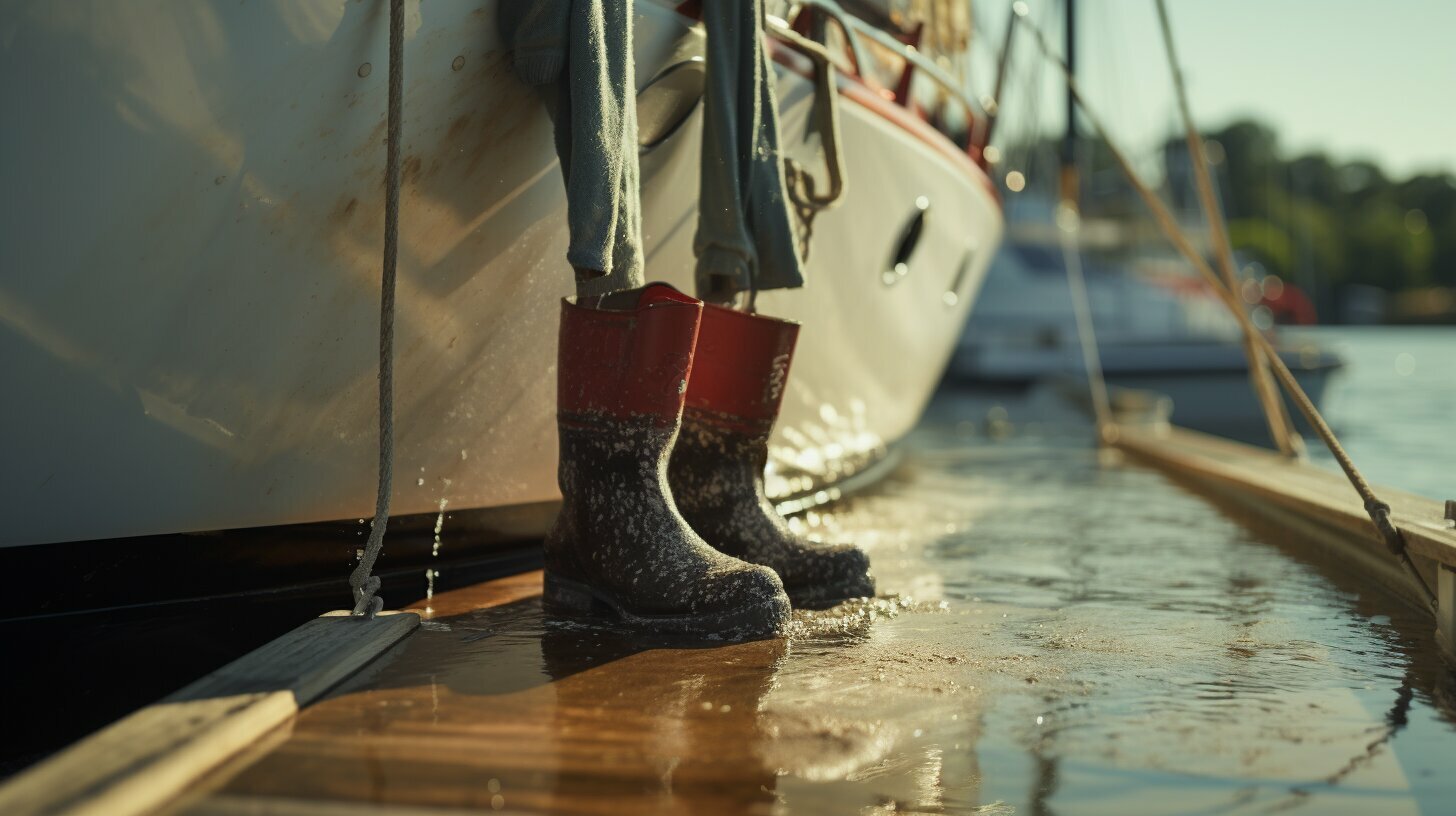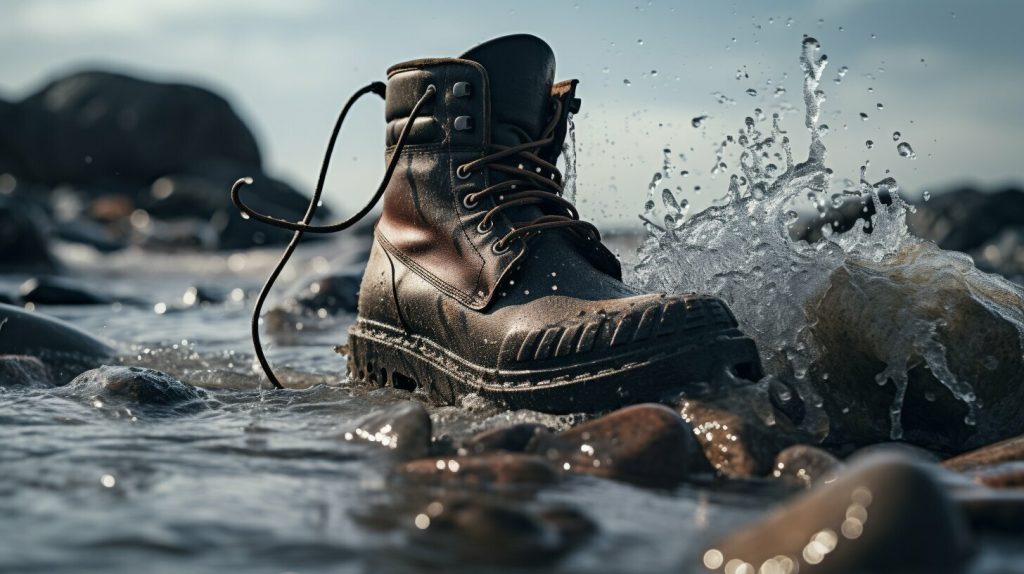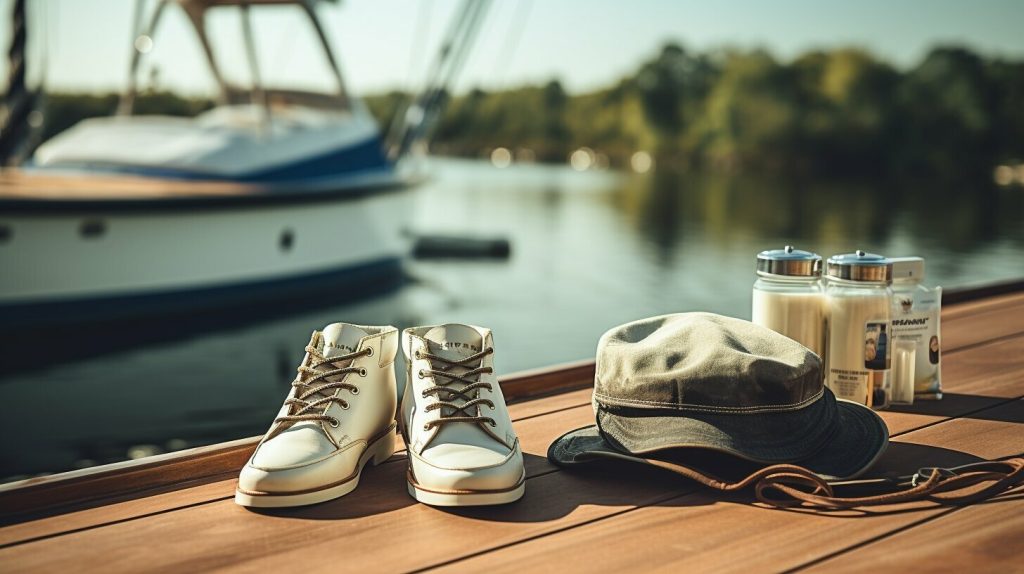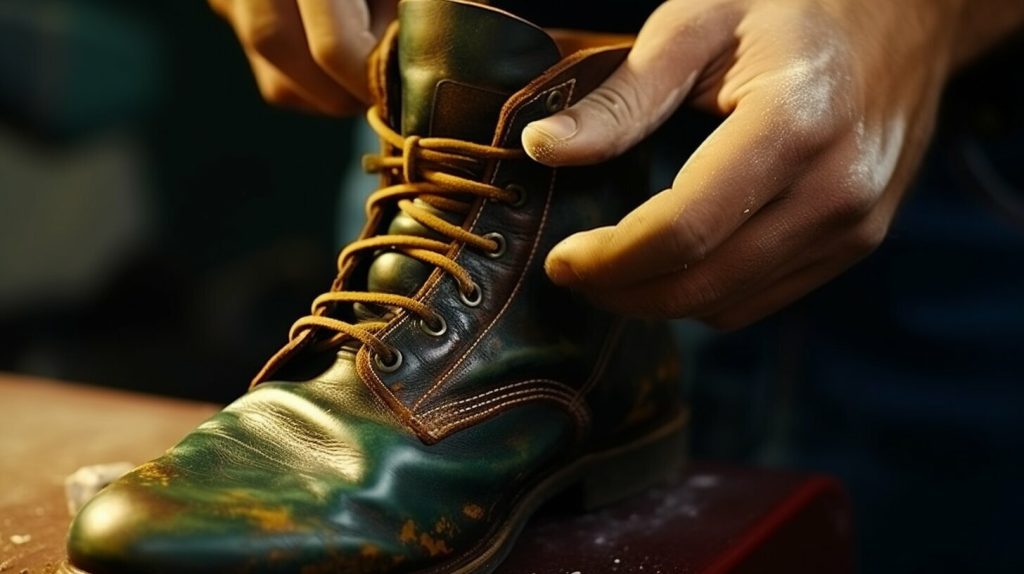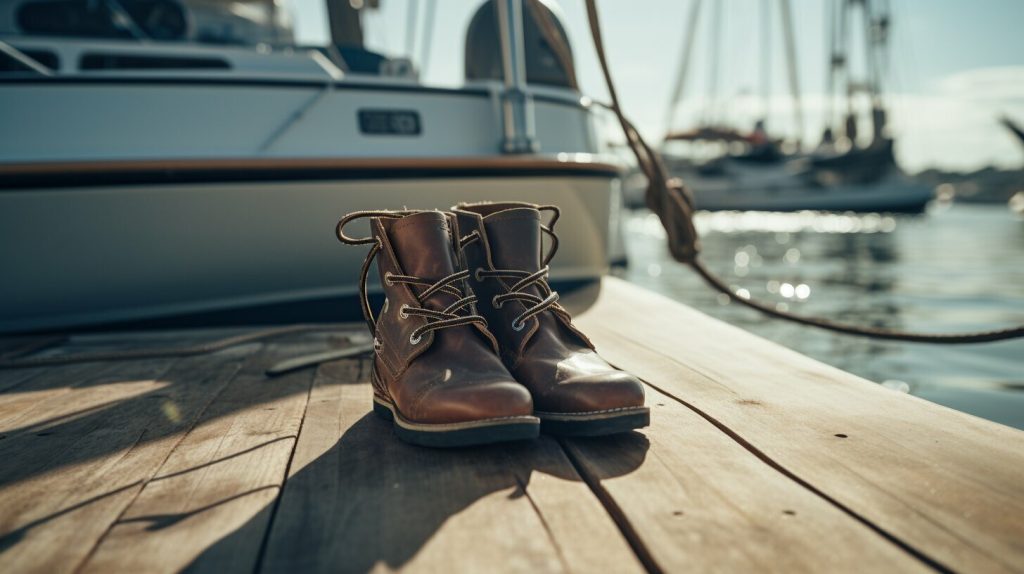Cleaning sailing boots is an important task to ensure their longevity and performance on the water. By properly maintaining and preserving your boots, you can keep them in shipshape condition all year round. In this comprehensive guide, I will walk you through the essential steps and provide valuable tips for cleaning and caring for your sailing boots.
- Rinse off dirt, mud, and saltwater with clean cold water.
- Scrub away stubborn grime using a brush.
- Apply a footwear protector spray to enhance water repellent properties and prevent cracking.
- Work leather cream into the smooth leather sections to keep them nourished and protected.
- Allow the boots to air dry naturally for 2-3 hours.
Gathering Your Cleaning Supplies
To clean your sailing boots effectively, gather the following supplies:
- A large bucket or basin
- Clean cold water
- A soft-bristle brush or sponge
- Mild soap or specialized sailing boot cleaner
- A footwear protector spray
- Leather cream suitable for sailing boots
- A clean, dry cloth
- Boot trees or rolled-up newspaper
- A boot bag for storage or travel
These supplies will ensure you have everything you need to clean, protect, and maintain your sailing boots.
“Having the right cleaning supplies is essential for keeping your sailing boots in great condition.”
Rinsing Off Dirt and Saltwater
Start by using clean cold water to rinse off any dirt, mud, and saltwater from your sailing boots. Ensure that you thoroughly rinse both the exterior and interior of the boots, paying extra attention to the soles and seams.
To remove stubborn salt stains, you can create a simple cleaning solution by mixing equal parts water and vinegar. Apply this solution to the affected areas and gently scrub with a soft brush or sponge. Rinse the boots again with cold water to remove any residue.
Remember to avoid using hot water as it can damage the materials. Additionally, do not use harsh detergents or solvents, as they can strip away the protective coatings and cause discoloration. Stick to gentle cleaning methods to preserve the integrity of your sailing boots.
| Materials Needed: | Cleaning Steps: |
|---|---|
| Clean cold water | 1. Rinse boots to remove dirt and saltwater. |
| Vinegar | 2. Create a vinegar cleaning solution. |
| Soft brush or sponge | 3. Gently scrub salt stains. |
By following these cleaning techniques for boat footwear, you can effectively remove salt stains and maintain the cleanliness of your sailing boots.
Scrubbing Away Stubborn Grime
Take a brush and gently scrub away any stubborn grime or dirt from the surface of your sailing boots. This step is crucial in maintaining the cleanliness and appearance of your boots. Pay special attention to any areas that have accumulated dirt or stains.
For tough stains or dirt that won’t easily come off, you can use a mild detergent or soap specifically designed for leather. Apply a small amount of the soap to the brush and gently scrub the affected areas. Be careful not to apply too much pressure, as this can damage the leather.
It’s important to note that different types of sailing boots may require different cleaning techniques. For example, if you have suede sailing boots, you should use a suede brush or eraser to remove any dirt or stains. Always refer to the manufacturer’s instructions or guidelines for cleaning specific types of sailing boots.
After scrubbing away the grime, rinse off any remaining soap residue with clean, cold water. Make sure to thoroughly rinse all areas of the boots, including the soles and seams. Once the boots are clean, gently pat them dry with a clean towel and allow them to air dry naturally for 2-3 hours.
| Tip: | For an extra level of protection, you can apply a waterproofing spray or wax to your sailing boots after they have dried. This will help to repel water and keep your boots in top condition. Be sure to follow the instructions on the product label for the best results. |
|---|
“Regularly cleaning your sailing boots and taking proper care of them will help extend their lifespan and ensure they remain comfortable and functional. By following these tips, you’ll be able to keep your boots in great shape all season long.” – Me
Applying Footwear Protector Spray
Spray a footwear protector evenly over the entire surface of your sailing boots to enhance their water repellent properties. This will help protect your boots from water damage and prevent cracking. It is important to choose a high-quality protector spray that is specifically designed for leather or suede materials.
When applying the spray, make sure to hold the bottle about 6-8 inches away from the boots and spray in a sweeping motion. Be sure to cover every part of the boots, including the seams and edges. Allow the boots to dry for a few minutes before moving on to the next step.
In addition to the water-repellent properties, some protector sprays also offer protection against stains and UV rays. This will help keep your boots looking new and prevent fading over time. Remember to reapply the protector spray periodically, especially after cleaning your boots, to maintain their protective properties.
By following these steps and applying a footwear protector spray, you can preserve the longevity and quality of your sailing boots, ensuring they are ready for your next adventure on the water.
Working Leather Cream into Smooth Leather
When it comes to maintaining sailing boots, taking care of the smooth leather sections is essential. This is where applying leather cream comes into play. By nourishing and protecting the leather, you can ensure that your boots stay in optimal condition for longer periods of time.
To begin, gather a small amount of leather cream and a clean cloth. Apply a small dollop of the cream onto the cloth and gently rub it into the smooth leather sections of your sailing boots. Make sure to cover the entire surface area, paying extra attention to any areas that may be more prone to wear and tear.
The leather cream will help to moisturize and soften the leather, preventing it from drying out and cracking. It will also provide a protective barrier against water, salt, and other elements that could damage the leather. By regularly applying leather cream, you can extend the lifespan of your sailing boots and keep them looking their best.
After working the cream into the leather, allow the boots to air dry naturally for 2-3 hours. This will ensure that the leather absorbs the cream properly. Once dry, your boots will be ready to wear and will have a renewed shine and softness.
Tips for working leather cream into smooth leather:
- Choose a high-quality leather cream that is specifically designed for smooth leather.
- Test the cream on a small, inconspicuous area of the boot first to ensure compatibility.
- Apply the cream in a circular motion, using gentle pressure to work it into the leather.
- Use a separate cloth to wipe away any excess cream after application.
- Repeat the process every few months or as needed to maintain the condition of your sailing boots.
By following these steps and taking the time to work leather cream into the smooth leather sections of your sailing boots, you can ensure that they remain well-maintained and protected for many adventures to come.
Allowing Boots to Air Dry
Leave your sailing boots in a well-ventilated area and allow them to air dry naturally for about 2-3 hours. This step is crucial to ensure that any remaining moisture evaporates completely, preventing the growth of mold or mildew. As the boots dry, avoid placing them near a direct source of heat like radiators or heaters, as this can cause the leather to crack or shrink.
To facilitate proper airflow, consider placing the boots on a boot tree or using toe fillers. These tools help maintain the shape of the boots while they dry, preventing them from becoming misshapen or developing creases. It’s important to let the boots dry in their natural shape, as this will ensure a comfortable fit and prolong their lifespan.
While waiting for your boots to dry, it’s a good time to inspect them for any signs of wear or damage. Check the stitching, soles, and seams for any loose threads or signs of deterioration. If you notice any issues, it’s best to address them promptly to prevent further damage and ensure that your boots are in optimal condition for your next sailing adventure.
Once your boots are completely dry, you can move on to the next step in maintaining them or store them properly until their next use. Taking the time to care for your sailing boots will not only keep them looking great but also ensure that they provide the support and protection you need during your time on the water.
Applying Leather Color Restorer (Optional)
If desired, apply a small amount of leather color restorer to enhance the leather finish of your sailing boots. This optional step can bring back the vibrancy and shine of your boots, giving them a renewed and polished appearance.
Before applying the color restorer, ensure that your boots are clean and dry. Use a soft, lint-free cloth to apply a small amount of the restorer onto the cloth. Gently rub the restorer onto the leather in circular motions, working it into the surface. Pay extra attention to any areas where the color has faded or become worn.
Allow the color restorer to dry for a few minutes, and then buff the leather with a clean cloth to remove any excess product. This will help to achieve an even finish and restore the original color of the boots. Remember to follow the instructions provided by the manufacturer of the color restorer for best results.
After applying the color restorer, your sailing boots will have a revitalized appearance, with the leather looking refreshed and rejuvenated. This step is especially beneficial for older boots that may have experienced color fading or wear and tear.
Remember, the color restorer is an optional step, and if you prefer the natural, worn-in look of your boots, you can skip this process. However, for those who want to maintain a polished and vibrant finish, the color restorer can be a valuable addition to your cleaning and maintenance routine for your sailing boots.
| Benefits of Applying Leather Color Restorer |
|---|
| Enhances the leather finish |
| Restores the original color |
| Revitalizes the appearance of the boots |
| Helps to hide minor scuffs and scratches |
Storing Your Sailing Boots
Store your sailing boots in a cool, dry place with consistent temperature, away from direct sunlight, to maintain their quality. Proper storage is crucial for preserving the longevity and performance of your boots. Here are some valuable tips to help you store your boots effectively:
- Remove any dirt or debris from your boots before storing them.
- Use boot trees or toe fillers to maintain the shape of your boots and prevent them from creasing.
- Place your boots in a breathable bag or shoe box to protect them from dust or moisture.
- Avoid storing your boots near heat sources or in damp areas that can cause mold or mildew.
- Consider using a dehumidifier or moisture-absorbing packets to keep the storage area dry.
- Label the storage container or bag to easily find your boots when needed.
By following these storage tips, you can ensure that your sailing boots remain in optimal condition when they are not in use. Proper storage will help extend their lifespan and keep them ready for your next sailing adventure.
Boot Storage Checklist
Use this checklist to ensure you have everything in place for storing your sailing boots:
| Item | Check |
|---|---|
| Remove dirt and debris from boots | ✔️ |
| Insert boot trees or toe fillers | ✔️ |
| Place boots in a breathable bag or shoe box | ✔️ |
| Avoid storing boots near heat sources or in damp areas | ✔️ |
| Consider using dehumidifier or moisture-absorbing packets | ✔️ |
| Label storage container or bag | ✔️ |
Follow these storage guidelines to protect your sailing boots and ensure they are ready for your next seafaring adventure. Remember, proper care and maintenance extend the life of your boots, allowing you to enjoy their comfort and functionality for years to come.
Proper cleaning and care of your sailing boots will help prolong their lifespan and keep them in great condition for your next sailing adventure. By following these simple and effective steps, you can ensure that your boots remain clean, well-maintained, and ready for any maritime challenge that comes your way.
Start by rinsing off any dirt, mud, and saltwater from your boots with clean cold water. Use a brush to scrub away any stubborn grime, ensuring that every nook and cranny is thoroughly cleaned. Once cleaned, apply a footwear protector spray to protect the leather from cracking and enhance its water repellent properties.
For leather sailing boots, it’s important to work leather cream into the smooth leather sections until it is absorbed. This will keep the leather nourished and protected, preventing it from drying out and losing its luster. After cleaning and applying necessary products, allow your boots to air dry naturally for 2-3 hours.
If you desire, you can further enhance the leather finish of your boots by applying a leather color restorer. This will bring back the vibrancy and shine of your boots, making them look brand new. Finally, store your sailing boots in a cool, dry place with a consistent temperature, away from direct sunlight.
Using boot trees and toe fillers will help maintain their shape, especially during periods of storage. And when traveling, protect your boots with boot bags to prevent any damage during transit. With the right care and attention, your sailing boots will continue to serve you well during all your sailing adventures.
FAQ
Q: How often should I clean my sailing boots?
A: It is recommended to clean your sailing boots after every use to remove dirt, saltwater, and grime.
Q: Can I use regular soap to clean my sailing boots?
A: It is best to use a mild cleaning solution specifically designed for leather or sailing footwear to avoid damaging the material.
Q: Can I machine wash my sailing boots?
A: No, machine washing can cause damage to the leather and other materials of your sailing boots. It is best to clean them manually.
Q: How do I remove salt stains from my sailing boots?
A: To remove salt stains, mix equal parts vinegar and water, and gently scrub the affected areas using a soft brush or cloth.
Q: Do I need to apply a protector spray after every cleaning?
A: It is recommended to apply a protector spray after every cleaning to maintain the water repellent properties of your sailing boots.
Q: How long should I let my sailing boots air dry?
A: It is best to let your sailing boots air dry naturally for 2-3 hours before storing them to ensure they are thoroughly dried.
Q: Can I use any leather cream on my sailing boots?
A: It is best to use a leather cream specifically formulated for sailing boots or similar leather footwear to ensure proper nourishment and protection.
Q: How should I store my sailing boots when not in use?
A: Store your sailing boots in a cool, dry place with a consistent temperature, away from direct sunlight. Use boot trees and toe fillers to maintain their shape.
Q: Should I polish my sailing boots?
A: Polishing your sailing boots is not necessary unless you want to enhance the leather finish. In that case, you can use a leather color restorer specifically designed for sailing boots.
Q: Can I use a regular shoe bag for traveling with my sailing boots?
A: It is best to use a dedicated boot bag for traveling with your sailing boots to provide extra protection and prevent them from getting squished or damaged.
